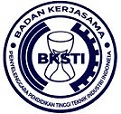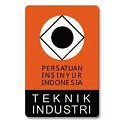Analysis of Mental Workload on Sugar Production Mechanical Workers Using the Nasa-TLX Method
Abstract
Workload can be defined as the difference between a worker's ability and job demands. Based on observations that have been made, it is known that madukismo sugar companies get an increasing demand value in each season of production, so this causes an increase in the number of working hours that apply to the company, which has the potential to increase their mental work. This study investigated the mechanical mental workload of workers at Madukismo Sugar Company using the NASA-TLX method, a multidimensional assessment tool. The NASA-TLX method is a multidimensional assessment method that can measure the overall mental workload to determine the mental workload felt by each worker. The results indicate a very high mental workload in some operators and suggest the need for operational adjustments. The recommendations are additional manpower and improved ergonomic levels to reduce stress and increase productivity.
Keywords: Mental Workload, NASA-TLX, Job Demands
Full Text:
PDFReferences
Masniar, A. R. Histiarini und D. A. B. Pangestu, „ANALISA BEBAN KERJA MENTAL MENGGUNAKAN METODE NASA-TLX PADA BAGIAN OPERATOR,“ Metode Jurnal Teknik Industri, pp. 11-20, 2022.
A. A. Putra, R. C. Pratama und A. P. Farahdiansari, „Analysis Of Mental Workload With NASA- TLX Method On Employees Of Kareb Bojonegoro Cooperative,“ JISTE (Jurnal Sistem Informasi, Teknologi dan Rekayasa), Bd. 1, pp. 95-103, 2023.
D. C. Dewi, „Analisis Beban Kerja Mental Operator Mesin Menggunakan Metode NASA TLX di PTJL,“ Journal of Industrial View, Bde. %1 von %2Volume 02, Nomor 02, pp. 20-28, 2020.
D. Diniaty und M. Ikhsan, „Analisis Beban Kerja Mental Operator Lantai Produksi Pabrik Kelapa Sawit Dengan Metode NASA-TLX di PT. Bina Pratama Sakato Jaya, Dharmasraya,“ Jurnal Teknik Industri, Bd. 4, 2018.
A. Maghfira, K. Joesyiana und A. R. Harahap, „PENGARUH BEBAN KERJA DAN KESELAMATAN KESEHATAN KERJA (K3) TERHADAP KINERJA KARYAWAN PT.HOKKAN DELTAPACK INDUSTRIBRANCH KAMPAR,“ Jurnal Pajak dan Bisnis, pp. 13-19, 2023.
Y. Rachmuddin, D. S. Dewi und R. S. Dewi, „Workload analysis using Modified Full Time Equivalent (MFTE) and NASA-TLX methods to optimize engineer headcount in the engineering services department,“ IOP Conference Series: Materials Science and Engineering, 2020.
N. Othman, U. N. Abdullah und F. I. Romli, „Evaluating Mental Workload Using Pupil Dilation and Nasa-Task Load Index,“ Proceedings of ACED SEANES, pp. 253-260, 2020.
A. P. Wirani, O. Julyanto, D. A. Kartini und Mukhlasin, „The Effect of Work Shift on Mental Workload of Maintenance Operator Using Nasa Task Load Index (TLX),“ Journal of Industrial Engineering & Management Research, Bd. 3, 2022.
S. Said, M. Gozdzik, T. R. Roche, J. Braun, Julian Rossler, A. Kaserer, D. R. Spahn , C. Nothiger und D. W. Tscholl, „Validation of the Raw National Aeronautics and Space Administration Task Load Index (NASA-TLX) Questionnaire to Assess Perceived Workload in Patient Monitoring Tasks: Pooled Analysis Study Using Mixed Models,“ JOURNAL OF MEDICAL INTERNET RESEARCH, 2020.
J. Armstrong, „Workload in engineering courses and how to reduce it,“ Proceedings of 8th Annual Conference of the Australasian Association for Engineering Education, 1996.
R. S. Dewi, A. Rahman und R. D. Astuti, „Workload Analysis in a University Maintenance Division,“ Industrial Engineering & Management Systems, Bd. 18, pp. 685-691, 2019.
J. Akyeampong, S. Udoka, G. Caruso und M. Bordegoni, „Evaluation of hydraulic excavator HumaneMachine Interface concepts using NASA TLX,“ International Journal of Industrial Ergonomics, pp. 374-382, 2014.
D. Junaedi, N. D. Rizkiyah und D. B. Pratya, „Determination of the Optimal Number of Workers Using the NASA-TLX Method in Chemical Company, Indonesia,“ International Journal of Engineering Research and Advanced Technology (IJERAT) , Bd. 6, 2020.
A. P. Harahap und Z. F. Rosyada, „ANALISIS BEBAN KERJA MENTAL MENGGUNAKAN METODE NATIONAL AERONAUTICS AND SPACE ADMINISTRATION –TASK LOAD INDEX (NASA-TLX) PADA OPERATOR LAS PRODUK STAY 1(Studi Kasus : Welding Divison PT Setia Guna Selaras),“ Industrial Engineering Online Jurnal, 2023.
N. I. Iskandar und R. Ade, „THE MEASUREMENT OF NURSES’ MENTAL WORKLOAD USING NASA-TLX METHOD (A CASE STUDY),“ Malaysian Journal of Public Health Medicine, Bd. 1, pp. 60-63, 2020.
A. P. Pratama, A. W. Rizqi und Hidayat, „Pengukuran Beban Kerja Fisik Dan Mental Pada Karyawan Dept.Fabrikasi Pada Perusahaan Manufaktur,“ Jurnal Teknik Industri, Bd. 9, 2023.
Mujiadi, H. Sudiyanto und S. Rachmah, „UPAYA PENINGKATAN KESEHATAN KERJA MELALUI PENDEKATAN POSISI ERGONOMI PADA KARYAWANPT. INTIDRAGON SURYATAMA KABUPATEN MOJOKERTO,“ Jurnal Abdimakes, Bd. Vol. 3, pp. 28-37, 2023.
M. I. Mulyati, „Metodologi Ergonomi Pada Redesain Sepatu Voli Dengan Pendekatan Ergonomi Total Meningkatkan Kenyamanan Dan Performa Atlet,“ Journal Locus Penelitian dan Pengabdian, Bd. Vol. 01, 2022.
A. S. Sanchez, „The Importance of Ergonomics in Industrial Engineering,“ Industrial Engineering & Management, 2014.
W. Susihono und I. P. G. Adiatmika, „Assessment of inhaled dust by workers and suspended dust for pollution control change and ergonomic intervention in metal casting industry: A cross-sectional study,“ Heliyon, 2020.
I. Ramadhanty, R. Marisdayana und R. Listiawaty, „PERBEDAAN TINGKAT KELELAHAN KERJA DAN BEBAN KERJA MENTAL PADA PEKERJA MINI MARKET DI KECAMATAN ALAM BARAJO TAHUN 2022,“ Jurnal Inovasi Penelitian (JIP), Bd. Vol. 3, pp. 7697-7708, 2023.
M. A.-F. F. Saputra und D. Herwanto, „Analisis Beban Kerja Mental Menggunakan Metode NASA-TLX Pada Divisi Produksi Perusahaan Empat Perdana Carton,“ Jurnal Serambi Engineering, Bd. Voleme VIII, pp. 4521-4528, 2023.
R. J. Novasani und R. Ngizudin, „Pengukuran Beban Kerja Pada Pegawai Kampus Menggunakan Cardiovascular Load Dan NASA-TLX,“ Jurnal Teknik Industri, Bd. 8, 2022.
R. A. Simanjuntak, „Analisis Beban Kerja Mental Dengan Metode Nasa-Task Load Index,“ Jurnal Teknologi Technoscientia, pp. 3(1), 78–86, 2010.
Hart & Staveland, The Workload, Jakarta: Universitas Indonesia Press, 1981.
A. M. Zain, „ANALISIS BEBAN KERJA MENTAL MENGGUNAKAN METODE NASA-TLX,“ dspaceuii, Yogyakarta, 2019.
Arasyandi & Arfan, „ANALISA BEBAN KERJA MENTAL DENGAN METODE NASA TLX PADA OPERATOR KARGO DI PT. DHARMA BANDAR MANDALA (PT. DBM),“ media.neliti, 2016.
Arief, „HUBUNGAN ANTARA UMUR DAN INDEKS BEBAN KERJA DENGAN KELELAHAN PADA PEKERJA DI PT. KARIAS TABING KENCANA,“ ppjp ulm, 2017.
R. T. I. P. &. Y. R. Ramadhan, „Analisa Beban Kerja Dengan Menggunakan Work Sampling Dan NASA-TLX Untuk Menentukan Jumlah Operator.,“ pp. 2(5), 964-973, 2014.
Resalfa, et al., „Analisis Beban Kerja Mental pada Pekerja Jasa Pengiriman XYZ Menggunakan NASA-TLX,“ Seminar dan Konferensi Nasional IDEC, pp. 2579-6429, 2022.
DOI: http://dx.doi.org/10.24014/jti.v10i1.29000
Refbacks
- There are currently no refbacks.
Copyright (c) 2024 Muhammad Faqih Zidan, Ratna Agil Apriani, Demas Emirbuwono Basuki, Latifah Fitri Nuraida Wibowo, Rifki Nurul Mukarim

This work is licensed under a Creative Commons Attribution-NonCommercial-ShareAlike 4.0 International License.
Jurnal Teknik Industri
P-ISSN 2460-898X | E-ISSN 2714-6235
Published by:
Industrial Engineering Department
Universitas Islam Negeri Sultan Syarif Kasim Riau, Indonesia
Office Address:
H.R. Soebrantas KM 15.5, Tampan, Pekanbaru, Riau, Indonesia 28293
email: jti.fst@uin-suska.ac.id
Indexed by:
JTI : Jurnal Teknik Industri under a Creative Commons Attribution-NonCommercial-ShareAlike 4.0 International License.

















